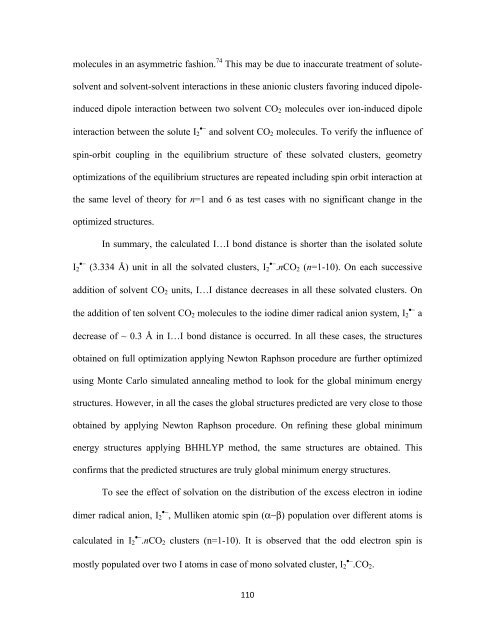CHEM01200604005 A. K. Pathak - Homi Bhabha National Institute
CHEM01200604005 A. K. Pathak - Homi Bhabha National Institute
CHEM01200604005 A. K. Pathak - Homi Bhabha National Institute
You also want an ePaper? Increase the reach of your titles
YUMPU automatically turns print PDFs into web optimized ePapers that Google loves.
molecules in an asymmetric fashion. 74 This may be due to inaccurate treatment of solutesolvent<br />
and solvent-solvent interactions in these anionic clusters favoring induced dipoleinduced<br />
dipole interaction between two solvent CO 2 molecules over ion-induced dipole<br />
interaction between the solute I •− 2 and solvent CO 2 molecules. To verify the influence of<br />
spin-orbit coupling in the equilibrium structure of these solvated clusters, geometry<br />
optimizations of the equilibrium structures are repeated including spin orbit interaction at<br />
the same level of theory for n=1 and 6 as test cases with no significant change in the<br />
optimized structures.<br />
In summary, the calculated I…I bond distance is shorter than the isolated solute<br />
I •− 2 (3.334 Å) unit in all the solvated clusters, I •− 2 .nCO 2 (n=1-10). On each successive<br />
addition of solvent CO 2 units, I…I distance decreases in all these solvated clusters. On<br />
the addition of ten solvent CO 2 molecules to the iodine dimer radical anion system, I •− 2 a<br />
decrease of ~ 0.3 Å in I…I bond distance is occurred. In all these cases, the structures<br />
obtained on full optimization applying Newton Raphson procedure are further optimized<br />
using Monte Carlo simulated annealing method to look for the global minimum energy<br />
structures. However, in all the cases the global structures predicted are very close to those<br />
obtained by applying Newton Raphson procedure. On refining these global minimum<br />
energy structures applying BHHLYP method, the same structures are obtained. This<br />
confirms that the predicted structures are truly global minimum energy structures.<br />
To see the effect of solvation on the distribution of the excess electron in iodine<br />
dimer radical anion, I •− 2 , Mulliken atomic spin (a-b) population over different atoms is<br />
calculated in I •− 2 .nCO 2 clusters (n=1-10). It is observed that the odd electron spin is<br />
mostly populated over two I atoms in case of mono solvated cluster, I •− 2 .CO 2 .<br />
110
















